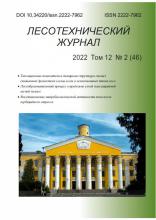Kirov, Kirov, Russian Federation
For the first time the mathematical model of task optimization for this scheme of cutting logs, including the objective function and six equations of connection. The article discusses Pythagorean area of the logs. Therefore, the target function is represented as the sum of the cross-sectional areas of edging boards. Equation of the relationship represents the relationship of the diameter of the logs in the vertex end with the size of the resulting edging boards. This relationship is described through the use of the Pythagorean Theorem. Such a representation of the mathematical model of optimization task is considered a classic one. However, the solution of this mathematical model by the classic method is proved to be problematic. For the solution of the mathematical model we used the method of Lagrange multipliers. Solution algorithm to determine the optimal dimensions of the beams and side edging boards taking into account the width of cut is suggested. Using a numerical method, optimal dimensions of the beams and planks are determined, in which the objective function takes the maximum value. It turned out that with the increase of the width of the cut, thickness of the beam increases and the dimensions of the side edging boards reduce. Dimensions of the extreme side planks to increase the width of cut is reduced to a greater extent than the side boards, which are located closer to the center of the log. The algorithm for solving the optimization problem is recommended to use for calculation and preparation of sawing schedule in the design and operation of sawmill lines for timber production. When using the proposed algorithm for solving the optimization problem the output of lumber can be increased to 3-5 %.
saw logs, cut width, beam, edged board, mathematical model, objective function, equation of connection, numerical method, task algorithm.
1. Agapov A. I. Optimizaciya raskroya pilovochnika srednih razmerov pri brusovo_razvalnom sposobe raspilovki [Optimization of cutting logs with a medium-sized lumber-cutting method breakup] Sovremennaya nauka _ aktualnie problemi i puti ih resheniya: 7-ya mejdunar. distancionnaya nauch. konf. [Modern science : actual problems and ways of their solution : 7-I-Nar. remote scientific. Conf.]. Lipeck, 2014, pp. 16 (In Russian). EDN: https://elibrary.ru/VCGHKN
2. Agapov A. I. Optimizaciya raskroya pilovochnika s vipilivaniem treh brusev raznoi tolschini i dvuh par bokovih dosok [Optimization of cutting logs with sawing out three beams of different thicknesses and two pairs of side boards] Aktualnie problemi razvitiya lesnogo kompleksa_ mejdunar. nauchno_tehnich. konf. [Actual problems of forest sector development: Intern. nauchno-tekhnich. Conf]. Vologda, 2014, pp. 62-66. (In Russian). EDN: https://elibrary.ru/VCGHKN
3. Agapov A. I. Vliyanie shirini propila na optimalnie razmeri brusev i dosok pri raskroe pilovochnika s vipilivaniem treh brusev odinakovoi tolschini i chetireh par bokovih dosok [Influence of the width of cut on the optimum size of the boards and the boards when cutting logs with three sawing boards of the same thickness, and four pairs of side boards] Lesotehnicheskii jurnal, 2014, Vol. 4, no. 2, pp. 128-135. (In Russian). DOI: https://doi.org/10.12737/4517; EDN: https://elibrary.ru/SJEIMN
4. Aksenov P. P. Teoreticheskie osnovi raskroya pilovochnogo sirya [Theoretical Foundations of cutting sawlogs]. Moscow, 1980, 216 p. (In Russian).
5. Vetsheva V. F. Raskroi krupnomernih breven na pilomateriali. [Cutting large-sized logs for lumber] Moscow, 1976, 168 p. (In Russian).
6. Villiston E. Proizvodstvo pilomaterialov [Production of sawn timber]. Moscow, 1981, 384 p. (In Russian).
7. Vlasov G. D. Novie metodi tehnologicheskih raschetov v lesopilenii [New methods of technological calculations in the sawmill]. Moscow, 1954, 60 p. (In Russian).
8. Kaliteevskii R. E. Lesopilenie v 21 veke. Tehnologiya_ oborudovanie_ menedjment.[Lumbering in the 21 century. Technology, equipment, management.] Saint Petersburg, 2008, 496 p. (In Russian).
9. Kaliteevskii R. E. Proektirovanie lesopilnih potokov [Design flows sawmills]. Moscow, 1972, 184 p. (In Russian).
10. Rikunin S. N. Planirovanie raskroya sirya metodom lineinogo programmirovaniya [Raw material cutting planning using linear programming]. Moscow, 1965, no. 8, pp.25-27. (In Russian).
11. Sobolev I. V. Optimizaciya raskroya pilovochnogo sirya [Optimization of cutting sawlogs]. Moscow, 1971, 36 p. (In Russian).
12. Stoev G. I. Opredelenie maksimalnogo vihoda pilomaterialov [Determination of the maximum output of sawn timber]. Moscow, 1961, 64 p. (In Russian).
13. Ulasovec V. G. Tehnologicheskie osnovi proizvodstva pilomaterialov [Technological bases of lumber production]. Ekaterinburg, 2002, 510 p. (In Russian).
14. Tahvanainen T. [et al.] Combined production of sawn timber and firewood billets at a birch sawmill in Finland Wood Material Science & Engineering, 2008, Vol. 3, Issue. 1-2, pp. 1-11.
15. Gil A., Frayret J.-M. Log classification in the hardwood timber industry: method and value analysis International Journal of Production Research, 2016, Vol. 54, I. 15, pp. 4669-4688.
16. Pilkerton S. J., Sessions J., Kellog L. D. Development of efficient cutting patterns to maximize value with a logallocation constraint International Journal of Forest Engineering, 2013, Vol. 24, I. 1, pp. 42-52.
17. Beel M. [et al.] Product potential of paulownia timber. Australian Forestry, 2005, Vol. 68, I. 1, pp. 3-8.
18. Todoroki C. Accuracy considerations when optimally sawing pruned logs : internal defects and sawing precision Nondestructive Testing and Evaluation, 2003, Vol. 19, I. 1-2, pp. 29-41.
19. Todoroki C., Rönnqvist M. Dynamic control of timber production at a sawmill with log sawing optimization Scandinavian Journal of Forest Research, 2002, Vol. 17, I. 1, pp. 79-89.












